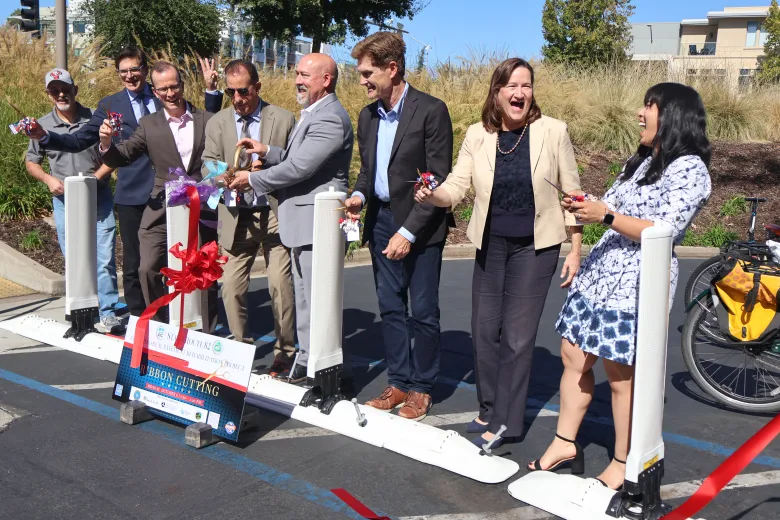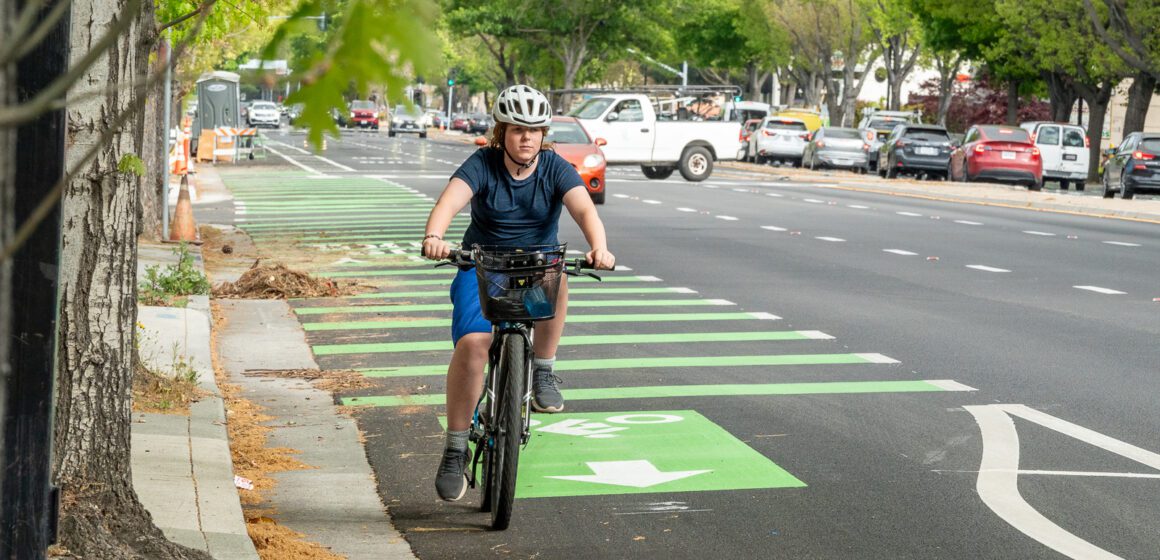State and local officials on Monday celebrated the completion of the suddenly popular but sparsely used bike lanes on El Camino Real with a ribbon-cutting ceremony that was attended by dozens of cyclists and advocates for safer streets.
City officials from Mountain View, Los Altos and Palo Alto voiced their appreciation for the project’s completion and for the numerous regional and state agencies that collaborated to make it possible. The project had initially divided Palo Alto’s elected officials and bike advocates, with many critics arguing that El Camino is a dangerous route and that cyclists should be steered toward safer and slower streets such as Park Boulevard. Others complained about the loss of parking all along the El Camino corridor, which displaced the dozens of RVs that had previously parked along the thoroughfare and have since relocated to other streets.
But with no real leverage to stop the project on what is technically a state highway, Palo Alto officials began to collaborate with Caltrans to modify the design plans and add new safety features at El Camino intersections that serve as school routes.
The criticisms that had defined the early phase of the project were notably absent Monday as Caltrans and local officials lauded their partnership and the final result.
“Normally it takes a village to deliver something,” said Nick Saleh, district division chief at Caltrans. “To be honest, it took like three villages, three big villages.”
The changes to El Camino include the addition of 13.5 miles of bike lanes in either direction, which are protected along most of the route by thick plastic bollards, as well as repaving from the southern border of Mountain View to the northern border of Palo Alto. A number of ADA improvements were also installed at intersections along the route, such as improving curb ramps and crosswalks.
In total, the repaving project that includes the new bike lanes cost around $55 million and years of collaboration between the cities and Caltrans, which has ultimate authority over El Camino, also known as State Route 82.
“This project, although long in duration, underscores the importance of partnership,” said state Sen. Josh Becker. “It underscores the importance of partnership between all of our different communities and with the state to get something done and really to take the time and listen to the residents. … We really took the time to listen to the residents, get that input, and said, ‘What is the best project possible for our community?’”
Cyclists have historically avoided El Camino due to its lack of bicycle infrastructure and its six wide lanes for vehicles, which often travel significantly faster than the posted 35 mph speed limit. Although the route is a useful thoroughfare to connect many cities along the peninsula, cyclists still appear hesitant to take advantage of it.

“What we’re talking about today is mobility and how it’s essential for our economic health, community life and long-term sustainability. … It’s a real win for our entire community – all users of El Camino,” said Mountain View Mayor Ellen Kamei, whose city kicked in $3.7 million toward the project.
Over a 15-minute period after the ribbon-cutting ceremony on Monday, reporters with this publication observed just one cyclist using the new bike lanes in either direction in Palo Alto. In the past, cyclists have told this publication that they prefer cobbling together a slightly longer route on parallel streets that have fewer cars as opposed to taking El Camino.
The lack of bicyclists on El Camino has also caught the attention of many Palo Alto residents, who aired their frustrations in letters to the City Council and on Nextdoor. For the past several months since the bike lanes opened, many have expressed excitement or even surprise at finally spotting a cyclist using the dedicated lanes.
At the same time, business owners along El Camino are frustrated that the new bike lanes have replaced store-front parking spots.
“The recent removal of street parking in favor of bike lanes on El Camino Real, while a noble effort to promote alternative transportation, has created a significant challenge for businesses that do not have their own private parking facilities,” Tony Lee, the owner of Stanford Coin Wash, wrote to the council in August. “Since the removal, many of these small establishments have reported a substantial and disheartening decline in customer foot traffic, directly impacting their ability to sustain their operations.
A number of intersections now also have “no right turn on red” signs, in large part to protect cyclists and vehicles from colliding on El Camino. That provision of the project received by far the loudest applause from cyclist attendees at the ribbon-cutting ceremony, but it is also the most contentious among drivers who say it slows them down.
“This restricts turning southbound onto El Camino when there is a red light,” College Terrace resident Drew Pearson wrote to the council in June. “I strongly disagree with the decision to put this rule into effect.”
Although the bike lanes are perhaps the most visible upgrade to El Camino, state Assemblymember Marc Berman gave a glowing review of the repaving effort for vehicle traffic as well.
“It’s definitely about the bike improvements and the pedestrian improvements, but it’s also about repairing potholes,” he said at the ceremony. “I used to joke that you could hide a small child in them.”
The repairs to the pavement also benefit the many bus routes that use El Camino, said Palo Alto Vice Mayor Vicki Veenker, who praised the fact that visitors will have a “less bumpy introduction” to the city.
Dave Ambuehl, acting district director for Caltrans Bay Area, said that the El Camino effort is “more than just a pavement project.”
“It’s an investment in safety and sustainability and the future of mobility along the El Camino Real.”
This story originally appeared in Palo Alto Weekly. Riley Cooke is a reporter at Palo Alto Weekly and Palo Alto Online focusing on city government.



Leave a Reply
You must be logged in to post a comment.